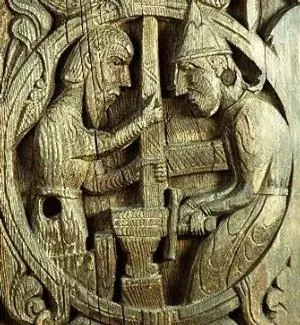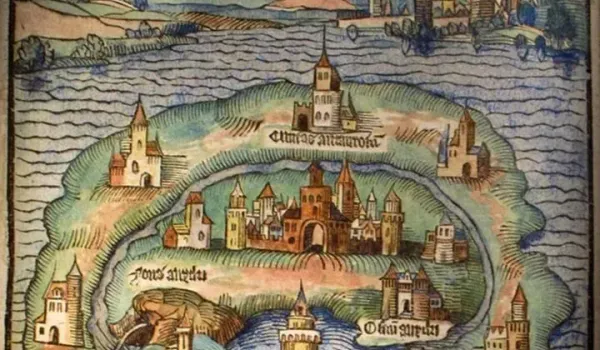Encountering Fate as Viking Men and Women

Fate sits at the heart of the Nordic sagas, lurking beneath the surface of the text like the ships intentionally sunk at Roskilde. Unseen but absolutely essential to those in the know. Detractors of these works (perhaps students in their initial exposure to this category of literature), will complain that a large portion of the sagas’ texts are just lists of events: Sven’s son married Sigrid and their son Bjorn went to Scotland and made his fortune there, where he held a great feast and then married Gjauflag, the daughter of Thorolf Blister-pate. These sections go on for ages, and they grate on the sensibilities of the uninitiated reader, who complains, “Why are you telling us about all these people who aren’t in the story?” Even after pushing through the inventory sections to reach the actual plot of a saga, that can still seem tedious. Events are recounted in straightforward, utilitarian prose, in the order that they occur. Settings are rarely established, and often, places are simply named rather than described. Moments of interiority are rare. Characters are defined not by their feelings or thoughts, but by their actions. For the modern reader, that sparseness makes it challenging to become invested in characters, to immerse themselves in tenth-century Scandinavia, but that challenge is worth facing. Delving deeper into the “Viking” world and its works, the reader realizes the meanings behind this minimalism and develops an appreciation for the style. Places are not established in florid prose for an unfamiliar reader, they were identified for an audience that should already be familiar. Characters are not defined by inner thoughts or expositional monologues; their actions define them because action was the only quality that could define a person. The overarching structure of the sagas, that linear format of unceasing forward momentum, reveals a great deal about the cultural understanding of fate and free will. “Governing beings of every kind—mortal and divine, living and dead—was the preordination of the future; it lay at the heart of the Norse mind-set. For the Viking-Age Scandinavians, fate did not represent the absence of choice but rather the manifestation of a pre-existing truth. Free will existed, but exercising it inevitably led to becoming the person you always, really, had been” (Price 72). There are times in the sagas where heroic characters are faced with clearly stated prophecy, facets of their lives foretold in plain terms. Their reactions, both immediately and throughout their lives, give great insight into what Vikings considered the “best” attitudes towards fate. The ways in which individuals fulfilling different gender roles address their fates, too, speaks volumes.
In The Saga of the People of Laxardal, the majority of the narrative revolves around Gudrun Osvifsdottir’s life. Gudrun was “the most beautiful woman to have ever grown up in Iceland, and no less clever than she was good looking… She was the shrewdest of women, highly articulate, and generous as well” (Laxardal 63). When her kinsman Gest Oddleifsson, an wise man and seer, passes by her family’s farm, Gudrun greets him and after a long and shrewd conversation, she asks Gest to interpret some dreams that have been troubling her. She declares: “No one has yet been able to interpret them to my satisfaction, although I don’t insist they be favourably interpreted” (65). In this disclaimer, Gudrun’s character is illuminated. She is concerned about the meaning of these dreams but wishes to understand the implications in their entirety. The truth, no sugarcoating. She recounts the dreams and awaits Gest’s interpretation. Each of the four dreams, he says, represents one of the four husbands she will have, and how each of her marriages will go. None of them will go well and each of these relationships has flaws and clear sources of pain for Gudrun. The first will end in divorce, the second husband (“for whom [she] will care greatly”) will drown, the third will be killed (“in part because of your own carelessness”), and the fourth will have some encounter with a specific fjord on the day of his death (Laxardal 66-67). These are not vague horoscopes, they are specific, well-articulated interpretations from a highly respected source of wisdom in Gudrun’s community that should be treated as reliably as an observation about the day’s weather. These events will almost certainly come to pass. Gudrun’s response, one of the most expressive moments in the entire saga, speaks volumes:
“Gudrun had grown blood-red while listening to her dreams being interpreted, but kept silent until Gest had finished.
Then she spoke: ‘You would have made a prettier prediction if I had given you the material for it, and I thank you for interpreting the dreams for me. I will have plenty to think about if all of this comes to pass as you say.’
Gudrun then repeated her invitation to Gest to visit them for the day” (Laxardal 67).
Consider the ramifications of what Gudrun has just heard. One of the smartest, most capable and beautiful young women in her entire country has just been told that she will suffer greatly throughout her life. She lives in a world where, because of her sex, she has few protections against domestic violence and assault, where her chances of dying in childbirth are high, where her prospects of owning land or even merely being independent are slim and anomalous. A piece of archaeological context: “At least in central Sweden, a consistent pattern seems to emerge with up to 7 percent of men having been malnourished as children compared to up to 37 percent of women. Child mortality was high, estimated at between 30–60 percent, which leads to an inescapable conclusion: girls and boys were given different amounts and qualities of food, strongly to the advantage of the boys and to a potentially life-threatening degree for the girls” (Price 193). These are the fundamental conditions of womanhood in the Viking era. Add atop that the likely future of recurring love and loss that Gest has just laid out, and the entire picture becomes overwhelming. The expressiveness that the narrator grants Gudrun in this moment is telling. Her face turns blood-red, yet she doesn’t contradict, interrupt, or complain. Instead, she simply accepts that these prophecies will be interesting if they come to pass and politely invites Gest to join her family for a time. Gudrun is among the best of her people, so when she faces down her cruel fate with stoic resolve, she does so as an example of a proper Viking woman.
To match Gudrun Osvifsdottir tragedy for tragedy with a man in one of the sagas we’ve read would be impossible. None of them suffer quite so much loss nor live such long lives, as heroic Viking men never become elderly, but Sigurd, from The Saga of the Volsungs, comes close. He is an Odin-blessed warrior who’s tasked with avenging his family and killing the dragon Fafnir. Prophecy occurs at multiple stages through his story, his lovers Gudrun and Brynhild have their own scene of dream interpretation about their relationships to him (an interesting parallel for another paper), but this is the key scene for Sigurd’s relationship with fate:
“There was a man named Gripir, the brother of Sigurd’s mother. Soon after the sword had been made, Sigurd went to meet with Gripir because this uncle could see into the future and knew the fate of men. Sigurd asked Gripir how his life would go. For a long time Gripir was unwilling to answer, but finally, yielding to Sigurd’s fervent pleas, he told him his whole fate, exactly as it later came to pass. And when Gripir had told him these things, as he had asked, Sigurd rode home. Soon afterward he and Regin met, and Regin said: ‘Kill Fafnir, as you have promised.’ Sigurd answered: ‘I shall do that, but first I must do something else: avenge King Sigmund and my other relatives who fell’” (Volsungs 60).
Sigurd’s seer, unlike Gudrun’s, does not want to relay his destiny. While he doesn’t have a happy ending, he still has great glory ahead of him and the hardships he will eventually face are essentially the result of his incredible achievements and heroic stature. Why wouldn’t the seer want to share that? There’s a clear, gendered divide. Gest didn’t mind telling Gudrun about all her hardships, because they will be done to her. She is a woman, so she has no agency and must simply endure what will come, and the suffering in her life will center on herself. Sigurd, however, is a man. He will make his fate, and by that reasoning, all of the suffering that will come to himself or those around him becomes, in some way, his fault. For Gudrun, knowing her fate could be framed as a mercy: she may harden her heart and prepare herself for what will come. Sigurd, on the other hand, is given the chance to be spared that burden. However, he insists on finding out what will happen, then treats it as a to-do list. This demonstration of resolve cements his greatness.
Gripir’s prophecy is not laid out for the reader like Gest’s, but the content is confirmed to be definitive, accurate, and comprehensive. In that conversation, Sigurd finds out everything that will ever happen to him. He learns then and there that he will avenge his family and slay the dragon. Great! He also learns that while he will fall in love with Brynhild, Gudrun’s family will drug him into forgetting her and make him marry Gudrun instead. He learns how and when he will be killed, that his death will break Brynhild’s heart and that she’ll kill herself as a result. Sigurd is handed an itemized list of every bit of suffering he will ever be a part of, yet he welcomes the opportunity to face it all. The lesson here is straightforward: act bravely, seek wealth and glory, and face the consequences for your actions head on. Deliberate ignorance is not bliss, it is a sign of weakness.
There are two stages to wrestling with prophecy: accepting the burden of knowledge and trying to change your fate. Oedipus Rex predates the Viking age by almost fifteen centuries, but the concept of contesting the outcomes of prophecy seems absent from the Norse mindset. Gudrun Osvifsdottir makes no effort to flee or change her fate. Instead, she retreats within herself, observing the machinations of fate with resignation. When her final husband, Thorkel, tells her of a dream he’s had about his beard spreading over Breidafjord, she simply remarks, “I am inclined to believe that it means that you will be dipping your beard into Breidafjord” (Laxardal 164). She doesn’t tell him not to go to sea, doesn’t plead for his life, and he drowns in a storm. When a ghost comes to tell Gudrun of his death, she responds bitterly, “keep silent about it, you wretch” (Laxardal 170). Sigurd, too, faces his fate head on. In light of the burdensome knowledge he carries, this scene is incredibly powerful: “One evening when they sat together drinking, the queen rose, went to Sigurd, and said to him: ‘It is a great joy for us that you are here and we wish to set all good things before you. Take the horn and drink.’ He accepted it and drank from it” (Volsungs 78). That moment is rendered flatly, squashed by the ages into a straightforward and bare-bones telling, but that leaves room for the imagination. This great hero, yearning to marry the woman he loves, willingly takes the drink he knows will cause years of heartbreak and death. Did he taste the drink? Or was it flavorless as his mind raced, trying to remember Brynhild, his love, for the last time, trying to hold her face in his memory as she faded away?
One of the interesting facets of Viking history is that Old Norse had no word for ‘town’. Vikings who traveled to Constantinople, the biggest city in Europe in that time, simply called it Miklagarðr, the ‘big garðr’ or Great Place (Price 451). Etymology can reveal a great deal about societal priorities and outlook. I wondered, given the attitudes about predestination and fate displayed in these sagas, if there was an Old Norse word for free will. As it turns out, there is: sjálfvilja is found in the Egils Saga, the Fóstbrœðra saga, and Stjórn, though those works are all dated later than The Saga of the Volsungs and The Saga of the People of Laxardal, both more ancient and foundational works. For Viking men and women raised on these two sagas, living out the designs of fate is clearly a noble and right act, though the nuances of how to do that are incredibly gendered. Women may as well know their fates, for they’ll suffer them anyway, and the greatest women face their lives of misery and danger with a stiff upper lip. Meanwhile men will wreak havoc on the world around them, seeking treasure, siring children, and slaughtering whoever gets in their way. Great Viking men will force the world to suffer them before going out in a blaze of glory.
This mindset has clear implications for interpreting Viking culture and history. A moral framework where men can do whatever they want and absolve themselves of any innate shame or guilt because they are “just fulfilling their fate”, combined with a belief system centered on the acquisition of wealth and violent glory, neatly sets the stage for the brutal hydrarchy of the ninth, tenth, and eleventh centuries. The active/passive binary seen in these two instances of encountering fate illustrates well the two ends of the power spectrum illustrated by Clover’s Regardless of Sex. People who are hvatr will prosecute their fate, and people who are blauðr will have fate done unto them. No matter where a person fell on that spectrum, though, it is clear that a willingness to face fate with solemn obeisance was one of the most laudable character traits a Viking-age person could have.
Works Cited
Price, Neil S. Children of Ash and Elm: A History of the Vikings
Clover. Regardless of Sex





